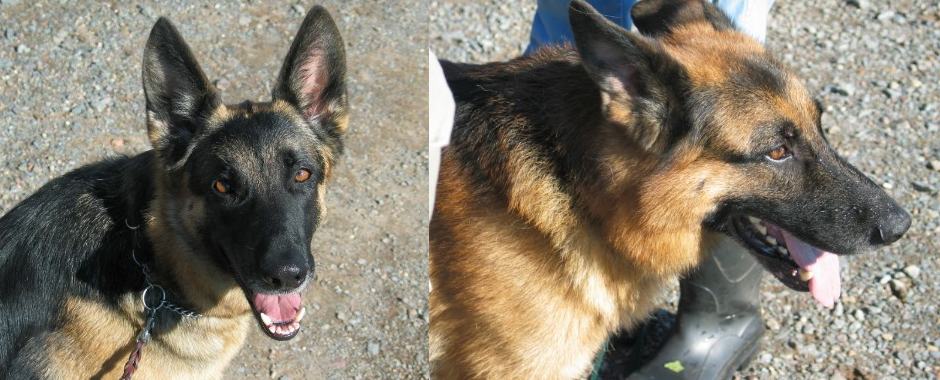
The German Shepherd Dog - Breed History
This brief history is not intended to be all inclusive. It is an outline of breed history from a North American perspective.
The German Shepherd Dog is respected and admired throughout the world for its versatility, intelligence, and loyalty. It has existed as a recognized breed for a relatively brief period of time compared to other dog breeds. The early shepherd dogs of Germany were of several types suited to their environments. Coat length and texture, color, and build all varied but these types all possessed ruggedness, intelligence, soundness, and the ability to do specialized work.
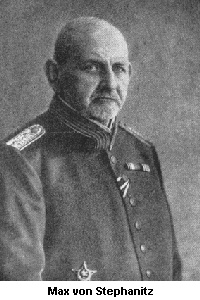 With advances in transportation and communication came the forming of societies of herders and the first trends toward selective breeding of herding dogs, record keeping, and a gradual trend toward one type of dog which could work equally well under all conditions. In 1881, the first formal club, the "Phylax" society was formed but lasted only about three years.
With advances in transportation and communication came the forming of societies of herders and the first trends toward selective breeding of herding dogs, record keeping, and a gradual trend toward one type of dog which could work equally well under all conditions. In 1881, the first formal club, the "Phylax" society was formed but lasted only about three years.
In 1889 Captain Max von Stephanitz began the standardization of the breed. It all started at a dog show in Karlsruhe in western Germany. A medium-sized yellow-and-gray wolflike dog caught his attention. The dog was of the primal canine type, supple and powerful, and possessed endurance, steadiness, and intelligence. He was a working sheepherder, born with this ability, requiring no training other than direction and finish to become proficient at the task. This dog, Hektor Linksrhein, was purchased by von Stephanitz, renamed Horand von Grafrath, and became the first registered German Shepherd Dog.
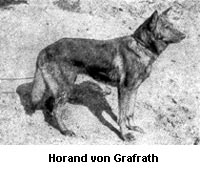 Von Stephanitz founded the Verein für Deutsche Sch·ferhunde, SV (German Shepherd Dog Club), becoming the first president, and in a short period of time achieved the standardization of form and type in the breed. A standard was developed based on mental stability and utility. The captain's motto was "Utility and intelligence". To him beauty was secondary, and a dog was worthless if it lacked the intelligence, temperament, and structural efficiency that would make it a good servant of man. A breed standard was developed as a blueprint dictating the exact function and relationship of every aspect of structure, gait, and inherent attitude.
Von Stephanitz founded the Verein für Deutsche Sch·ferhunde, SV (German Shepherd Dog Club), becoming the first president, and in a short period of time achieved the standardization of form and type in the breed. A standard was developed based on mental stability and utility. The captain's motto was "Utility and intelligence". To him beauty was secondary, and a dog was worthless if it lacked the intelligence, temperament, and structural efficiency that would make it a good servant of man. A breed standard was developed as a blueprint dictating the exact function and relationship of every aspect of structure, gait, and inherent attitude.
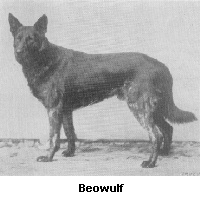 Von Stephanitz inbred heavily on Horand and also Luchs, his brother, to consolidate the bloodline. Horand's best son, Hektor von Schwaben, the second German Sieger, was mated with his half-sister as well as through daughters of his own sons, Beowulf, Heinz von Starkenberg, and Pilot III.
Von Stephanitz inbred heavily on Horand and also Luchs, his brother, to consolidate the bloodline. Horand's best son, Hektor von Schwaben, the second German Sieger, was mated with his half-sister as well as through daughters of his own sons, Beowulf, Heinz von Starkenberg, and Pilot III.
Intense inbreeding also concentrated undesirable recessive originating from the mixing of the original strains. Von Stephanitz then inserted unrelated blood of herding origin through Audifax von Grafrath and Adalo von Grafrath.
As Germany became increasingly industrialized and the pastoral era declined, von Stephanitz realized the breed might also decline. With the co-operation of police and working dog clubs a set of specific tests was developed in tracking, formal obedience, and protection work. This was the prototype of the present Schutzhund trials. He persuaded the authorities to utilize the German shepherd dog in various branches of government service. The dog served during the war as Red Cross dogs, messenger dogs, supply carriers, sentinel, tracking and guard dogs.
The first German Shepherd Dog exhibited in America was in 1907. Mira von Offingen, imported by Otto Gross, was shown by H. Dalrymple, of Port Allegheny, Pennsylvania in the open class at Newcastle and Philadelphia. The first championships awarded German Shepherd Dogs was in 1913. In 1913 the German Shepherd Dog Club of America was formed by Benjamin Throop and Anne Tracy, with 26 charter members.
The German Shepherd Dog Club of America's first specialty show was at Greenwich, Connecticut in 1915. In 1917, when America entered World War I, all things German became tabu. The American Kennel Club changed the name of the breed to the Shepherd Dog and the German Shepherd Dog Club of America became the Shepherd Dog Club of America. In England, the name of the breed was changed to the Alsatian.
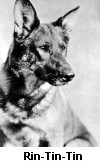 With the end of World War I came a new appreciation for the breed. The German Army had made good use of the breed as a war dog. Tales told by returning U.S. fighting men, some bringing shepherds with them, and the intelligence and striking appearance of the dogs caught the attention of the general public. Rin-Tin-Tin and Strongheart, whose movies played on variations of the "boy and his dog" theme, shot the popularity of the breed sky-high. Puppy factories flourished to meet the demand, gutting the American market with poor quality "German police dogs", resulting in a down-turn in popularity of the breed.
With the end of World War I came a new appreciation for the breed. The German Army had made good use of the breed as a war dog. Tales told by returning U.S. fighting men, some bringing shepherds with them, and the intelligence and striking appearance of the dogs caught the attention of the general public. Rin-Tin-Tin and Strongheart, whose movies played on variations of the "boy and his dog" theme, shot the popularity of the breed sky-high. Puppy factories flourished to meet the demand, gutting the American market with poor quality "German police dogs", resulting in a down-turn in popularity of the breed.
Serious breeding did continue such as by Mrs. Harrison Eustis, of Fortunate Fields Kennels, in Switzerland. Her approach was completely scientific with exhaustive research of breedings undertaken. The most widely known usefulness to which her dogs were put was as guide dogs for the blind at the famous Seeing Eye in Morristown, New Jersey.
In 1922 Germany introduced a system of regular breed surveys - a criticism of each dog, with a graded description and recommendation for (or against) breeding. This type of system never caught on in America due largely to the cultural differences inherent in American society. However, good dogs were still produced as German dogs were easily available for American dollars highly sought after in inflationary Germany.
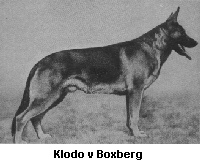 Von Stephanitz had become alarmed at the trend in the breed toward oversized square dogs. Other problems included lack of steady temperament and faults of dentition. He and the breed wardens decided drastic measures needed to be taken. At the 1925 Sieger show von Stephanitz selected Klodo von Boxberg as world sieger. This dog was dramatically different from the type of dog that had gone before him. He was of lower station, deeper and longer in body, short in loin and with a far-reaching gait. As it turned out Klodo proved to be a potent sire, successfully heralding a "new" type of shepherd. That same year Klodo was imported to America by A. Gilbert of Maraldene Kennels in Hamden, Connecticut. Klodo, through a number of important sons and daughters, is largely responsible for the faults and virtues of modern North American lines.
Von Stephanitz had become alarmed at the trend in the breed toward oversized square dogs. Other problems included lack of steady temperament and faults of dentition. He and the breed wardens decided drastic measures needed to be taken. At the 1925 Sieger show von Stephanitz selected Klodo von Boxberg as world sieger. This dog was dramatically different from the type of dog that had gone before him. He was of lower station, deeper and longer in body, short in loin and with a far-reaching gait. As it turned out Klodo proved to be a potent sire, successfully heralding a "new" type of shepherd. That same year Klodo was imported to America by A. Gilbert of Maraldene Kennels in Hamden, Connecticut. Klodo, through a number of important sons and daughters, is largely responsible for the faults and virtues of modern North American lines.
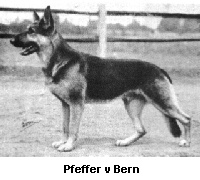 In 1936 John Gans imported Sieger Pfeffer von Bern and in 1938 Sidney Heckert Imported Odin vom Busecker Schloss. Through their intense inbreeding and line-breeding, these were dogs that molded the majority of our modern day lines. Pfeffer was German Sieger in 1937 and had a great show career in America. Through Pfeffer a uniform type in America was established but with the faults of long coats, missing dentition, faulty temperament, overlong bodies and loins, and orchidism (missing one or both testicles).
In 1936 John Gans imported Sieger Pfeffer von Bern and in 1938 Sidney Heckert Imported Odin vom Busecker Schloss. Through their intense inbreeding and line-breeding, these were dogs that molded the majority of our modern day lines. Pfeffer was German Sieger in 1937 and had a great show career in America. Through Pfeffer a uniform type in America was established but with the faults of long coats, missing dentition, faulty temperament, overlong bodies and loins, and orchidism (missing one or both testicles).
The German Shepherd Dog was widely sought after during World War II, employed by Allied and Axis forces, as mine detectors, sentinels, guard work, messenger, and other services. In America, Dogs for Defense was formed, providing thousands of dogs to the army.
The paths of German and American shepherds diverged after World War II. The Americans continued largely with the Pfeffer and Odin lines while in Germany the breed was in poor shape. Many dogs had been killed or destroyed due to lack of food. The best that was left was bred, frequently outcross breedings, since there was no great selection of line-bred stock. Soon the breeders had individual dogs dominant in the desired virtues. They then began to line-breed or inbreed so that by about 1949 quality specimens began to appear at German shows. The pedigrees of these "new" dogs were largely of the result of "type" breeding without the influence of Pfeffer but having the great dogs behind him. Prepotent sires emerged, Axel von der Deininghauserheide, Rolf vom Osnabruecker-land and Hein v. Richterback, representing preserved pre-war genetics.
Through Pfeffer, American breeders established a beautiful type. This was concentrated by inbreeding, and in combinations with descendants of his half-brother Odin vom Busecker-Schloss. Many well-known kennels of the day, utilizing these lines were Long-Worth, founded by Lloyd Brackett, Liebestraum, owned by Grant Mann, and Hessian, owned by Art and Helen Hess.
 In 1950's America, some breeders recognized the need for some infusion of outcross blood and this was done through Klodo Boxberg and Odin Stolzenfels lines which blended well with American taste for topline, croup length and rear angulation. The Axel/Rolf/Hein combinations were also brought in notably by Troll von Richterback. Troll, 1957 Grand Victor, had remendous appeal. He was dominant in producing rear drive, hindquarter strength, muscle, bone, and head. He was also dominant in producing straight uppper arm, weak ears, blues, and fading pigment.
In 1950's America, some breeders recognized the need for some infusion of outcross blood and this was done through Klodo Boxberg and Odin Stolzenfels lines which blended well with American taste for topline, croup length and rear angulation. The Axel/Rolf/Hein combinations were also brought in notably by Troll von Richterback. Troll, 1957 Grand Victor, had remendous appeal. He was dominant in producing rear drive, hindquarter strength, muscle, bone, and head. He was also dominant in producing straight uppper arm, weak ears, blues, and fading pigment.
Imports critical to the breed in America were Bernd v Kallengarten and Falk v Eningsfeld. Bernd was imported by Ernie Loeb. Bernd was dominant for shoulder, forehand, bone, feet, substance, suspension, head, croup, tailset, and body length but also weaknesses for ears, steep croup, loose ligamentation, long coats, and high percentage of hip and elbbow dysplasia. Of note is the fact that Bernd introduced the solid-black gene into the American breed.
During the 1960's there was an emergence of strong families of stud dogs. In Germany the SV was in control while in America breeders were open to follow their own preferences. Troll wielded a large amount of clout in America by producing the famous "F" litter Arbywood, including Fels, Field Marshall, Fortune and Fashion, bred by Lucy Woodard. This pedigree combined Odin Stolzenfels/Klodo Boxberg/Pfeffer/Utz as well as the Axel/Rolf/Hein combination. The Arbywood males contrasted with their pure American counterparts, being stallion males with the desired type.
 Fortune was bred to Fran and Joan Ford's Frohlich's Elsa v Grunestal producing Lance of Fran-Jo, American and Canadian Granvd Victor. Lance represented a new era in American shepherds - angulation, topline and sidegait. Lance's popularity in the sixties was also due to the American tendency to turn away from imports, perhaps due to cost and poor quality. Lance was geographically convenient to all parts of the U.S.A. and was widely used.
Fortune was bred to Fran and Joan Ford's Frohlich's Elsa v Grunestal producing Lance of Fran-Jo, American and Canadian Granvd Victor. Lance represented a new era in American shepherds - angulation, topline and sidegait. Lance's popularity in the sixties was also due to the American tendency to turn away from imports, perhaps due to cost and poor quality. Lance was geographically convenient to all parts of the U.S.A. and was widely used.
Lance produced many offspring which in turn became pillars of the breed in America, including Lakeside's Harrigan, Cobert's Reno of Lakeside, Eko-Lan's Morgan, Cobert's Golly Gee of Lakeside and Mannix of Fran-Jo. Important offspring of these dogs included Doppelt-Tay's Hammer and Hawkeye who figured prominently in the late seventies.
Also concentrating on Lance and figuring prominently in the breed were Zeto of Fran-Jo and Zeus of Fran-Jo.
Also important during Lance's time was Yoncalla's Mike, a Bernd v Kallengarten grandson consolidating the Pfeffer/Odin blood. Mike was a potent sire transmitting balanced structure, rich colour, strong bone and good feet. Mike's best known son was Grand Victor Hollamor's Judd whose daughters were also widely used.
In Germany a very active market developed for German Shepherd Dogs sought in countries such as Japan, Italy, Scandinavian countries, South America, France, and others. The SV matured with innovation such as the "a" stamp, a tattoo identification system, emphasis on producing bloodlines, and stricter regulations for top ratings given to dogs. In America the reverse happened as show status was emphasized, professional handlers began to control the sport and systems such as the Futurity/Maturity system emphasized early breeding of dogs before their true genetic worth became clear.
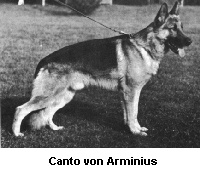 The emerging sires of Germany were Quanto Wienerau, Canto Wienerau, Mutz vd Pelztierfarm, and Marko v CellerLand. Quanto was a dominant producer giving low-stationed, medium sized progeny with good forequarter, strong bone and heads, and good type but also some fading pigment, east/west pastern conformation, cowhocks, and short, flat croup. He produced many famous sons such as Dick Adeloga and Lasso di val Sole. Quanto linebreeding has continued in importance through dogs such as Uran v Wildsteiger Land.
The emerging sires of Germany were Quanto Wienerau, Canto Wienerau, Mutz vd Pelztierfarm, and Marko v CellerLand. Quanto was a dominant producer giving low-stationed, medium sized progeny with good forequarter, strong bone and heads, and good type but also some fading pigment, east/west pastern conformation, cowhocks, and short, flat croup. He produced many famous sons such as Dick Adeloga and Lasso di val Sole. Quanto linebreeding has continued in importance through dogs such as Uran v Wildsteiger Land.
Canto only lived about four years yet had an important impact on the breed in Germany. Canto passed on style, energy, and desire to show and move which was sought after by international buyers. Canto produced well when crossed with Quanto lines as well as traditional working lines. His famous son Canto Arminius was also a dominant force in the breed.
The SV began to place more and more importance on training degrees. The mid-sixties saw a minimum Schutzhund 1 degree, and the AD, an endurance test. Temperament and courage tests became more demanding, and the SV forced breeders to concentrate on problem areas such as missing teeth, poor croups, etc. Since SV officials were also the jduges at the Sieger show it was only the animals meeting their dictated requirements that received the top honours. Schutzhund 3 become mandatory for the top VA awards.
To this point, the mid-eighties, we end this brief history. Although starting with a common base, the breed in Germany and America has taken a separate but parallel course. The Americans, largely through Lance, and the Germans, largely through Canto and Quanto, have evolved closely-bred, although differing breeds in looks, movment, style, and structure. Both systems have cemented both desirable and undesirable characteristics into the breed. The Americans have the option to persue their own views and choose their own bloodline courses whether from within or outside their country. The Germans, controlled by the SV, will likely continue to look within to develop the breed. The future will be interesting for the breed in both countries ...
About The Breed
General Facts | Breed History | Raising Your Dog
Related Activities
Tracking | Obedience | Herding | Agility | Schutzhund
Articles
Temperament Test | Aggression
